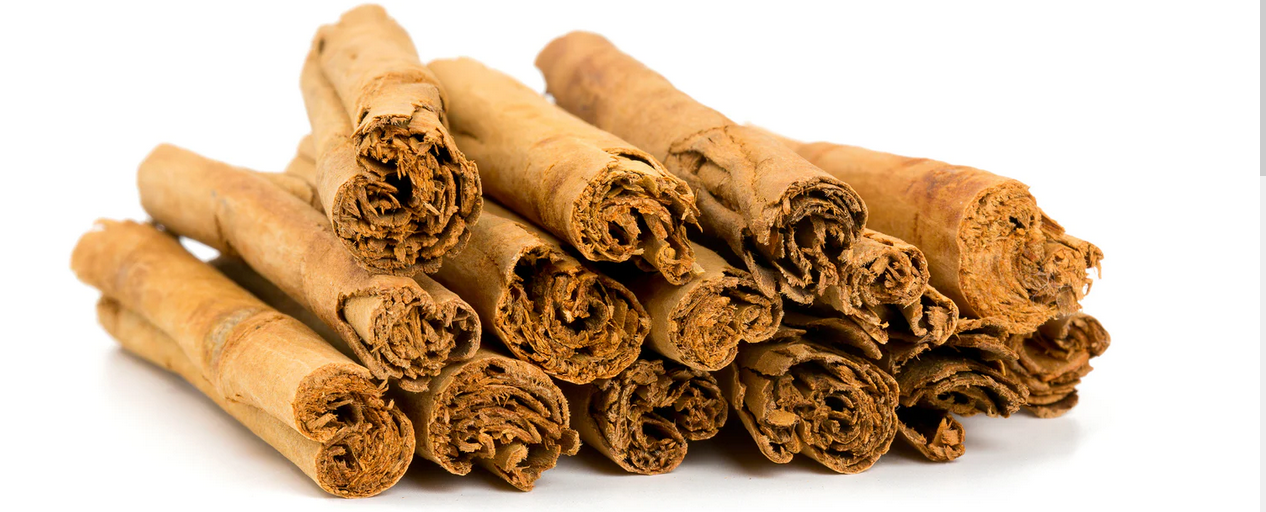
Ceylon Cinnamon
Lighter in colour and taste than the Cassia Cinnamon, Ceylon Cinnamon Sticks are quite mild and exudes bright citrus tones of flavour with a hint of sweetness. Favoured by chefs world over, and loved by home cooks, our Cinnamon quills are delicate and offers a clean and bang-on Cinnamon flavour unlike the Cassia. Ceylon Cinnamon contains a less amount of coumarin (a naturally derived flavour substance which can be toxic to ones body if consumed in larger quantities) compared to Cassia.
FAQ on coumarin in cinnamon and other foods
Coumarin is a flavouring substance which is contained in relatively high concentrations in cinnamon varieties collectively known as "Cassia cinnamon". In especially sensitive persons, even comparatively small quantities of coumarin can cause liver damage, although the effect is usually reversible. Isolated coumarin must not be added to foods. However, to flavour foods, coumarin-containing plant parts may be used. For cinnamon-containing foods, new maximum permissible coumarin levels have been in place in the European Union since 2011. In contrast, there are no limit values for cinnamon as a spice.
Consumers who take cinnamon-based food supplements should be aware that such products may contain high quantities of Cassia cinnamon. The BfR recommends moderate consumption of Cassia cinnamon. Consumers who frequently use large amounts of cinnamon as spice in their home cooking, for example for rice pudding with sugar and cinnamon, should use Ceylon cinnamon which contains low levels of coumarin.
What is coumarin and where is it found?
Coumarin is a natural flavouring and fragrant substance contained in many plants. It is contained in relatively high concentrations in varieties of cinnamon collectively known as “Cassia cinnamon” and also, for example, in woodruff, tonka beans and melilot.
What is coumarin used for?
Synthetically produced coumarin is used in cosmetic products; it smells of fresh hay. In addition, coumarin is used in medicine as a drug for treating oedemas. Isolated coumarin must not be added to foods. If it is contained in parts of plants added to foods to flavour them (as is the case with cinnamon), the coumarin quantity is, according to the new European aroma law, restricted for certain cinnamon-containing foods.
How much coumarin does cinnamon contain?
A rough distinction into two types of cinnamon can be made: Ceylon cinnamon only contains low levels of coumarin which in the opinion of the BfR are safe in terms of their health effects. Cassia cinnamon contains higher levels of coumarin. For this reason, it is not advisable to consume large quantities of it over prolonged periods of time.
Are there limit values for coumarin in foods?
The new European flavouring regulation lays down limit values for cinnamon-containing foods. Thus the maximum content for “traditional and / or seasonal bakery ware containing a reference to cinnamon in the labelling” (for example cinnamon stars) is 50mg (milligrams) per kg of food. For desserts (for example rice pudding with cinnamon), the limit is 5mg per kg of food. The new limit values have been in place since January 2011.
Are there limit values for coumarin in cinnamon?
No limit value currently exists for coumarin in cinnamon. The new European flavouring regulation does not lay down any general limit values for natural ingredients contained in herbs and spices.
Is too much coumarin potentially detrimental to human health?
The use of coumarin for medicinal purposes has shown that even relatively low doses can lead to liver damage in a small group of especially sensitive persons, if the drug is administered for a few weeks. In mild cases, this leads to an increase of liver enzymes in the blood. In severe cases, it results in inflammation of the liver which can manifest as jaundice. The precise mechanism leading to these symptoms is not known. However, the effects are usually reversible. In contrast, no such cases of liver damage following consumption of cinnamon have been described in the scientific literature to date.
Can coumarin provoke cancer?
In animal experiments, very large doses of coumarin administered over long periods of time did provoke cancer in rats and mice. For humans, however, there are no indications that tumours may be triggered by coumarin.
How does the BfR assess the health risk posed by coumarin in cinnamon?
The BfR has assessed the health risk that may be posed by coumarin in foods. It emerged that in animal experiments and when administered to sensitive persons as a drug, coumarin could damage the liver. For this reason, the BfR then derived a tolerable daily intake (TDI). This is the amount that a person can ingest daily over a lifetime without appreciable health risk. The TDI is 0.1mg (milligrams) of coumarin per kg of bodyweight and day and it also applies to especially sensitive consumers. This means that an adult with a body weight of 60kg can consume 6mg of coumarin every day for the rest of their life without any noticeable health impairment. The European Food Safety Authority has calculated the same value in its assessment of coumarin. If this value is exceeded in the short run, this does not pose any health risks.
How high are coumarin levels in cinnamon as a spice?
Data of food monitoring shows that Cassia cinnamon on average contains approximately 3000mg (3g) of coumarin per kg of cinnamon. However, the highest measured levels were as high as 10000mg (10g) of coumarin per kg of Cassia cinnamon.
How much coumarin is contained in cinnamon-containing foods?
The studies conducted by the food control authorities in 2006 revealed that the maximum coumarin level of 2mg per kg of food in force back then was clearly exceeded. Thus in cinnamon stars, for example, up to over 100mg per kg of food were detected.
Does the consumption of cinnamon-containing foods pose a risk for consumers?
It is only possible to exceed the tolerable daily intake with food alone, if the limit value of 50mg per kg of food is reached completely and if large amounts of such foods are eaten on a daily basis. For small children with a body weight of 15 kg, the TDI would be reached if they ate 30g of cinnamon stars (about 6 small cinnamon stars) or 100g of ginger bread cake every day, provided that no other coumarin exposure from other sources occurs. For adults (with a body weight of 60kg) this equals more than 120g of cinnamon stars (about 24 small cinnamon stars) per day. As with other foods, the BfR recommends consumption in moderation. It must be borne in mind in this context that coumarin can additionally enter the body via cosmetic products such as coumarin-containing body lotions and body oils.
Does the ingestion of cinnamon as spice pose a risk to consumers?
Since slight exceeding of the TDI for one to two weeks can be seen as safe, a health risk for consumers is only possible, if they eat very large amounts of Cassia cinnamon with high coumarin contents over an extended period of time. An adult with a body weight of 60kg reaches the TDI by consuming about 2g of Cassia cinnamon per day. A small child with a body weight of 15kg reaches its TDI by ingesting about 0.5g of Cassia cinnamon.
Does the ingestion of cinnamon as a food supplement pose a risk to the consumer?
Consumers taking cinnamon-based food supplements should be aware that these products may contain high levels of coumarin. The coumarin content of cinnamon supplements varies and depends on the type of cinnamon used as well as the way it is processed. If Cassia cinnamon powder is taken, consumers may, depending on the recommended dose, exceed the TDI.
Ceylon Cinnamon Products
-
Набор из цейлонской коры корицы сорта Lakpura «Alba»
Обычная цена От руб1.200,00 RUBОбычная ценаЦена за единицу / заруб1.400,00 RUBЦена со скидкой От руб1.200,00 RUBРаспродажа -
Пакет «C5 Extra Special» класса «C5 Extra Special» с настоящей цейлонской корицей
Обычная цена От руб900,00 RUBОбычная ценаЦена за единицу / заруб1.100,00 RUBЦена со скидкой От руб900,00 RUBРаспродажа -
Набор «C5 Special» из цейлонской коры настоящей корицы Lakpura
Обычная цена От руб0,00 RUBОбычная ценаЦена за единицу / заруб0,00 RUBЦена со скидкой От руб0,00 RUB -
Набор из цейлонской коры корицы сорта Lakpura «C5»
Обычная цена От руб0,00 RUBОбычная ценаЦена за единицу / заруб0,00 RUBЦена со скидкой От руб0,00 RUB














